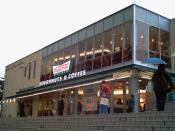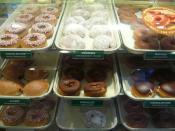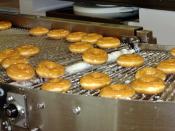Krispy Kreme's doughnut products belongs in the bread and roll market of the retail food industry. This market grew by 3.6% in 2003, and reached a value of $18.8 billion, in the United States alone. The market is expected to increase to $21.9 billion by 2008, an increase of 16.4%.
The industrial-white sector, which includes doughnuts, makes up the primary revenue source for he market, accounting for 51% of the market's value ("Bread & Rolls"). The market is a mature to declining market. Pricing remains low due to competition, but focus is on loyal niche consumers, especially for Krispy Kreme which has received almost cult status in many areas.
Promotion of Krispy Kreme's product focuses on its unique taste as its main differentiation, as well as their 'hot light' that signals to customers that their Original Glazed doughnuts just came right out of the oven ("Original Glazed").
The doughnut industry specifically generated sales of $4.7
billion in 2002, and is projected to reach $6.0 billion by 2007. This does not include grocery stores, convenience stores, or big box retail segments ("Krispy Kreme Doughnuts"). The company itself is moderately vertically integrated, handling distribution of doughnut mixes and equipment to their corporate and franchise stores, and utilizing other partner vendors for distribution of their products off-site.
Krispy Kreme has been in business since 1937 and has several strengths it relies upon. Despite this longevity and because of it, a new store opening often sees long lines from eager customers, thanks to a very strong brand name. A store located in Medford set an openingweek sales record of more $500,000 in sales. ("Krispy Kreme Doughnuts").
In addition, Krispy Kreme has 30.6% of the US market share. This is further complimented by the company's healthy balance sheet and cash flow. Their "debt-to-capital stands at...


